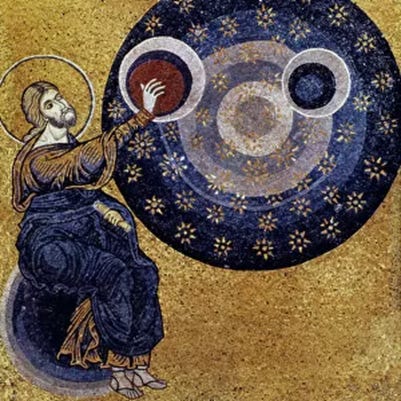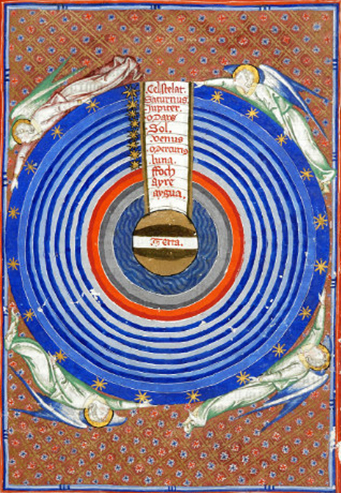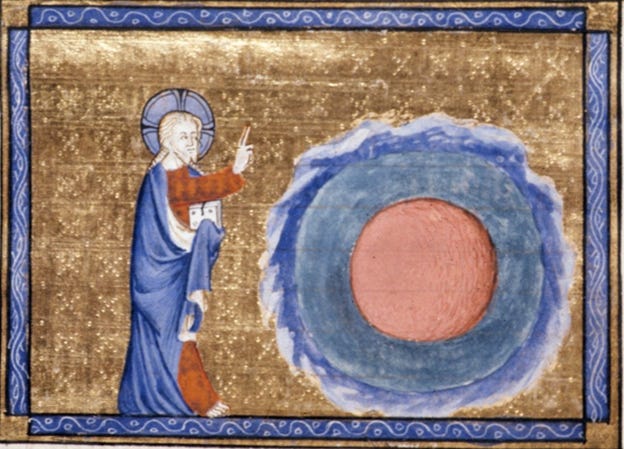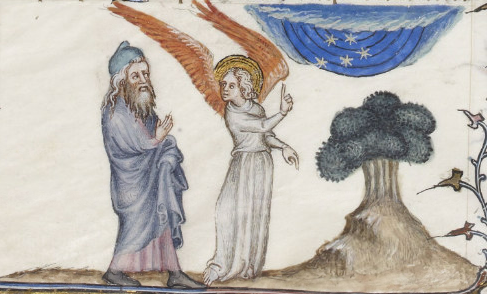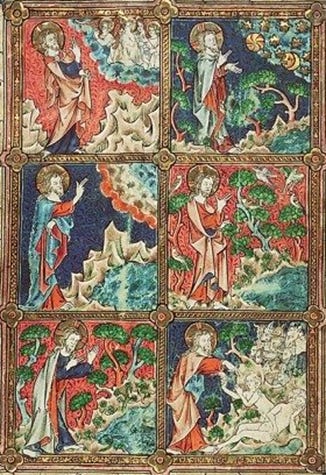The/anthropos - Part 2
On the Making of Man
Chapter one: Wherein is a partial inquiry into the nature of the world, and a more minute exposition of the things which preceded the genesis of man.
The first chapter of On the Making of Man commences with Genesis 2:4, as rendered in the Septuagint: “This is the book of the generation of heaven and earth.” It is noteworthy that Gregory places a verse of Scripture at the fore of his treatise. Ultimately, he is a steward and minister of the sacred logoi of the transcendent Logos. His quest for the truth of man brings him to the “living oracles” (Acts 7:38).
The modern mind is disturbed, perhaps, by this resort to revelation. Is not reason adequate to comprehend the nature of man, and every other created nature, too? The roots of this sentiment, which is not exactly absurd to us, run deep. Already in the thirteenth century we meet the claim: “[B]esides philosophical science, there is no need of any further knowledge” (St. Thomas Aquinas, Summa Theologiae I, 1, 1, obj. 2). Indeed, the (self-)sufficiency of rational discourse – at least with respect to created natures – is a presupposition of modern science. Again, it does not strike us as entirely ridiculous. Still, it invariably produces a closed epistemic system that excludes the possibility of illuminative intervention from transcendent sources. Yet the course of scientific discovery is replete with remarkable epiphanic moments, which might well discredit the hypothesis of epistemic impermeability, except that these episodes are narrated in purely psychological terms according to the conventions of the modern mythos.
At this juncture, we must take a brief look at “modernity,” for much of the Nyssen’s teaching will strike modern man as contrived, frivolous, or fantastical. And we are all “in” modernity, with more or less complacency. Modernity, as we understand it, is not so much temporal as ideal. Hence it is an “age” or “aeon” as traditionally understood: i.e., an arrangement of reality of basically psychical quality.
To clarify, we do not agree with those who advance a wholly negative appraisal of modernity. But a fair examination of its virtues and vices would take us far afield. We only cite some attributes germane to our discussion: namely, a shallow and intolerant empiricism that renders man insensible to divine realities and contemptuous of received sapiential resources. If we wish to derive benefit from Gregory, we must cultivate a critical awareness of the dominant psycho-spiritual paradigm. For when we approach his work, we do so as lovers and students of wisdom, wisdom that descends from above and is transmitted by the masters of divine learning. We are in the realm of sacra doctrina, participating in God’s knowledge of himself, as communicated in and to and through the blessed ones.
Gregory, of course, operates under the traditional assumption that the intellect is open to celestial lights. Some of these lights filter through the sacred page. Thus he begins with Scripture, which captures the splendor of the Logos. So let us return to Genesis 2:4.
Often, the phrase “heaven(s) and earth” is taken as a merism: a figure of speech denoting the whole by reference to the extremities. However, the Septuagint, unlike the Masoretic, provides “heaven” (οὐρανοῦ) in the singular. This invites Gregory to interpret each portion of the expression separately, such that “heaven” indicates the subtle body which “compass[es] all things round,” while “earth” indicates the dense body of “heavy and of downward tendency,” which occupies “the middle place of the universe.” The earth is “fixed” and “stationary,” whereas the heaven is “mobile,” revolving around with “exceedingly rapid motion … like a wheel.” The two elements preserve and perpetuate each other by “mutual action”: the “rapid motion” of the heaven “compresses the compact body of the earth,” while the earth “by reason of its unchanging fixedness continually augments the whirling motion” of the heaven.
Between the heaven and the earth Gregory locates intermediary elements: specifically, the air and the water. Each appropriates and commingles within itself the attributes proper to the extremes to which it is adjacent, “so that there is manifestly a mutual contact of the opposites through the mean.” Thus, the air and the water at once unite and divide the heaven and the earth.
Obviously, the Nyssen has a cosmology different from our own, with features typical of his late antique milieu. Some would assert that Gregory’s cosmology is not only different from ours, but also objectively false. We admit that it is deficient, although we find it not totally unsatisfactory from a phenomenological perspective. Really, there is much that could be said positively about alternative cosmologies, occidental and oriental, pre-modern and otherwise, but it would take a lot of care to distinguish the seed from the husk, and we cannot accommodate such an excursus. We merely suggest that the regnant cosmology, however empirically and mathematically persuasive, tends to resist a symbolic reading and offers little symmetry or isomorphism between cosmos and anthropos – thus it must be deemed somehow wanting.
In any event, Gregory’s primary aim is not to model the cosmos, but to identify the principles of creaturely being, with a view toward their anthropological significance. Thus he is a philosopher of nature in the classical sense, not a practitioner of astronomy or physics or cosmology, as such disciplines are contemporarily accepted. What are these principles of creaturely being that Gregory identifies? Rest and motion.
[A]s a sort of bond and stability for the things that were made, the divine power and skill was implanted in the growth of things, guiding all things with the reins of a double operation (for it was by rest and motion that it devised the genesis of the things that were not, and the continuance of the things that are)[.]
And similarly:
[The heaven and the earth], moreover, were first framed before other things, according to the divine wisdom, to be as it were a beginning of the whole machine, the great Moses indicating, I suppose, where he says that the heaven and the earth were made by God in the beginning, that all things that are seen in the creation are the offspring of rest and motion, brought into being by the divine will.
For Gregory, the earth reveals (we might say) the principle of rest, whereas the heaven reveals the principle of motion. These principles comprise a sort of primal ontological “dialectic.” However, the earth is not identical with rest, nor is the heaven identical with motion. Indeed, the Nyssen observes that these ostensible contraries display a “mixture of properties.” The earth, he says, is locally stable but materially or substantially mutable, whereas the heaven is locally mobile but materially or substantially immutable. Hence there is a “transposition” of properties: “unchangeableness in that which is ever moving, and change in that which is immovable.” Interesting: by eliminating the stark distinction between the uppermost and the lowermost elements, Gregory actually complicates the prevailing cosmological model of his day. But why?
Here Gregory introduces a theological consideration. Creation is characterized by change of one kind or another. Nothing is beyond alteration. This radical variability is the intention of divine wisdom, for it prevents the creature from “being accounted God.”
[T]the earth is stable without being immutable, while the heaven, on the contrary, as it has no mutability, so has not stability either, that the divine power, by interweaving change in the stable nature and motion with that which is not subject to change, might, by the interchange of attributes, at once join them both closely to each other, and make them alien from the conception of Deity[.]
Hence we see that Gregory establishes some basic premises: first, the stability but mutability of the earth; second, the mobility but immutability of the heaven; third, the combination and interpenetration of the properties of the earth and the heaven in the intermediary elements; fourth, the absolute stability and immutability of God over and against creation. “With whom there is no variation or shadow due to change…” (James 1:17).
However, we would be remiss if we did not observe that the mixed nature of creation not only provides a point of contrast with the Deity, but also a point of comparison. That is, the various elements bear some Godlikeness: for example, the earth exhibits stability, and the heaven exhibits immutability. Thus creation has an analogical relationship with the divine, characterized by similarity and dissimilarity.
Now we must ask whether Gregory’s interpretation is plausible. Is the “great Moses” – incidentally, we take seriously the Mosaic authorship of Genesis, with the thoughtful allowances granted by the Pontifical Biblical Commission (see Denz. 1997-2000) – really discoursing on the principles of motion and rest when he recounts the creation of the heaven and the earth? We gesture toward the venerable opinion that Moses spoke condescendingly to an ignorant people absorbed in the sensible (see, e.g., St. Thomas Aquinas, Summa Theologiae I, 68, 3, resp.). Also, we should not forget that, apart from any supernatural illumination, the holy seer was acquainted with the Egyptian arts and sciences (Acts 7:22). And were these very arts and sciences delivered, maybe, to the Egyptians by Abraham, Moses’s forebear, who hailed from Mesopotamia, that land of primordial wisdom (see, e.g., Josephus, Antiquities of the Jews I, 8, 2)? We are hesitant to dismiss such a thesis as ethnic chauvinism, though the proposition remains disputable under the conventional Scriptural chronology (even as traced by “conservative” commentators).
Gregory’s interpretation is less suspect – indeed, it is entirely reasonable – when we recognize that motion/rest is a culturally-specified construction of an elemental “complementary opposition” inscribed in the fabric of being and glimpsed, we would hazard, by every society, albeit from different angles. Moses evidently intuited this truth, or grasped it by tradition or revelation, as evidenced by the very structure of the creation narrative, with its many pairs of complementary opposites, especially that of man/woman (highly significant, given its Christological and ecclesiological – and, yes, cosmological – entailments). In other words, we do not need to suppose that Moses explicitly had in mind “motion” and “rest” to believe that he apprehended the reality articulated by such Hellenistic jargon. This conclusion does not, we think, do violence to the letter, nor does it demand any esotericism (although Scripture is certainly amenable to a moderately esoteric reading).
Gregory wraps up the first chapter with a vivid and picturesque sketch of newly-fashioned creation. The scene depicts a world complete, verdant, harmonious, lovely. It begs to be shared in full:
[T]he meadows were full of all that grows therein, and all the mountain ridges, and summits, and every hillside, and slope, and hollow, were crowned with young grass, and with the varied produce of the trees, just risen from the ground, yet shot up at once into their perfect beauty; and all the beasts that had come into life at God's command were rejoicing, we may suppose, and skipping about, running to and fro in the thickets in herds according to their kind, while every sheltered and shady spot was ringing with the chants of the songbirds. And at sea, we may suppose, the sight to be seen was of the like kind, as it had just settled to quiet and calm in the gathering together of its depths, where havens and harbours spontaneously hollowed out on the coasts made the sea reconciled with the land; and the gentle motion of the waves vied in beauty with the meadows, rippling delicately with light and harmless breezes that skimmed the surface[.]
Gregory apparently envisions the world as having sprung from the hand of God pristine and peaceful and perfect, albeit with a natural dynamism and intrinsic fruitfulness. We are reluctant to broach the difficult subject of “creationism,” which insinuates itself at this point. Candidly, it seems to us that the most natural reading of Moses – a reading to which the fathers (including Gregory) largely subscribed – is at odds with some of the apparent findings of modern science regarding, e.g., the age of the universe and the development of biological life. This is the case even bearing in mind the judicious allowances of the magisterium (e.g., Denz. 2128, 2302). Such inconsistency is perplexing. On the one hand, we refuse to embrace a ludicrous obscurantism, which would turn a blind eye to the insights of natural philosophy. As St. Thomas teaches: “[I]n discussions bearing on faith, we may use any truth of any science” (Commentary on Galatians Ch. 3, Lect. 6). (Actually, “must” is probably more proper than “may.”) On the other hand, we are not ready to set aside the common teaching of the fathers simply because it appears problematized by an inherently provisional and inductive enterprise (to wit, the empirical sciences). How to proceed? At the moment, it may be necessary to draw fruit from the tension – tension which, we are almost certain, will be resolved through the continued encounter of theology, philosophy, and the sciences. But we are ranging beyond our remit.
Anyway, everything seems just right in Gregory’s portrait of fresh creation. But where is man – where is he? Not to worry: the Nyssen has an eye toward his main subject. Thus he ends with an observation that startles and stirs the heart, and sets up the rest of the treatise: “All the wealth of creation by land and sea was ready, and none was there to share it” (emphasis supplied).
To be continued. The next installment will consider the treatise’s second chapter, “Why man appeared last, after the creation.”


